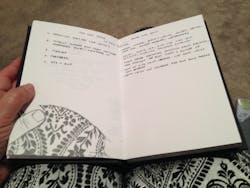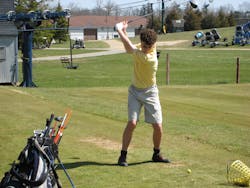This is the first in a series of three reflections on “Go See, Ask Why, Show Respect.”
In addition to being a lean practitioner in the insurance industry, I am an artist by training. I tend mostly towards abstract art, but since the beginning of this year I have been focusing on doing realistic renderings and each day have been drawing pictures in my sketchbook of objects around the house. Noticing me working on these drawings night after night, my husband said to me, “Looks like you are practicing drawing.” He was a little surprised when I answered, “I’m not practicing drawing; what I’m practicing is SEEING!”
Why practice SEEING? What could that mean, why would I be doing it every day, and what possible relationship could practicing SEEING have to lean?
First let’s think about the word “practice.” How do we improve our current level of skill at something? By practicing! If you want to improve your golf game, you might start by making a plan to go to the driving range to hit balls three times a week as well as engaging in your regular weekly golf game with friends. Getting out and putting in the time and effort to concentrate on improvement is one of the biggest components of practicing.
Practicing involves actively engaging in the activity that you want to improve on a regular basis, trying new skills deliberately and critically evaluating yourself, or even getting someone else to critically evaluate you. Deliberate practice means you have a clear purpose for the practice session, you are getting critical feedback, and making adjustments based on that feedback.
How about improving your ability to cook a fabulous gourmet meal? Maybe you decide to sign up for a series of cooking classes at your local park district. Every week the teacher shows the class how to cook a particular dish and the class cooks alongside as the teacher offers suggestions about how to improve knife technique and add seasonings. Homework each week? Cook the dish in your own home for your family—a wonderful critical audience. Again, actively engaging in the activity that you want to improve and deliberately practicing modeled expert behavior leads to improvement over time.
And how about running a half marathon? Perhaps you decide to join a community running group that meets every morning with a running coach. The coach watches your stride as you run, and gives tips and tricks and suggestions for improvement as progress is made. Each day the coach adds a little time and distance to the run, you build up your endurance, and finally, before you know it with daily practice you find that you can run that 13.1 miles no problem. With this example we have added the factor of having a clear and measurable target—a powerful motivator.
Deliberately practicing a skill over and over again is the way that we learn by DOING. And learning by DOING—especially with the help of a coach to guide your practice—is the key to continuously improving.
So why should we practice SEEING? Don’t we already know how to see?
Think about this situation: A friend of yours says that they are going to buy a new F-15 pickup, but you aren’t familiar with trucks in general, or that model. You can’t picture one in your mind at all. Once your friend gets the truck, however, and takes you for a ride, you suddenly start SEEING that type of truck everywhere. In fact it is the most popular truck on the road and they were there for you to see all along, but they escaped your selective filter of what you see.
A few years ago, my husband and I went on a tour of the Michigan factory where Ford F-15 trucks were made. We spent three hours watching the final assembly line where all the parts came together into a finished truck. Still excited from our tour and what we had “seen,” on the six-hour drive home on the highway, my husband and I actively looked for F-15 pick-up trucks. And both of us agreed that the most interesting thing is that not only could we now SEE the truck as a whole, but we noticed all the details of the parts that we had seen being put together.
And have you ever gone for a walk with a small child? When my kids were little I was always amazed at what they noticed while we were out for a walk that I didn’t: the shape of a leaf, the way the cracks in the sidewalk looked like a smiley face, small rocks to pick up, and many, many other things. We were looking at the same things, but I wasn’t “seeing” what they were seeing. Over time, I’ve come to realize that SEEING, like any other skill or ability, is something that we need to practice constantly in order to improve.
For a lean leader, SEEING is one of the most important foundational skills to have. A well-known and often-told story about Taiichi Ohno is that when new managers would come to Toyota, he would take a piece of chalk and draw a circle on the ground in the workplace near the work process the manager would be responsible for. Ohno-san would then ask the new manager to stand in the circle and watch. Hours later, Ohno-san would return and ask the manager to describe what he saw. Inevitably, the manager would not be able to describe the wastes and problems in the process in any detail. Although the manager had been standing at the process and looking, he hadn’t learned to SEE yet.
Ohno would not let the manager leave the circle until he could give a vivid description of what he saw, including all the wastes that could be improved upon. Ohno also would not tell the student what to see. When you go to gemba to observe a process, are you only spending time looking, or are you going to actively and deliberately SEE?
As a lean practitioner, I am constantly asking the people I coach and work with to “go SEE”: SEE how the process works, SEE what wastes/obstacles they can find in their processes, SEE what is really happening in the current state. I need to help them improve their ability to SEE by guiding their ongoing practice deliberately. And in order to be able to coach and help people improve their abilities to “SEE,” I need to constantly improve my ability to “SEE” as well, in the same way—by deliberately practicing, each and every day. So every night, I practice SEEING by drawing in my sketchbook.
What do you do to deliberately practice SEEING?
_______________________________________
Liker Leadership Institute (LLI) offers an innovative way to learn the secrets of lean leadership through an online education model that is itself lean, and extends that lean education far beyond the course materials. Learn more about LLI's green belt and yellow belt courses in "The Toyota Way to Lean Leadership" and "Principles of Lean Thinking" at the IndustryWeek Store.






